In a quiet corner of the Qatari capital, Doha, between an Indian restaurant and a hair salon, lies a nondescript housing compound once meant to host World Cup visitors.
Instead it’s become a temporary home for about 1,500 Palestinian medical evacuees from Gaza — a micro-sized Gaza-on-the-gulf and a living catalog of the horrors inflicted on the human body by the tools of war.
Arwa Ghanem, 10, in a wheelchair, third from right, plays with other Palestinian children in a housing compound for Gazan medical evacuees and their families in Doha, Qatar.
There’s 17-year-old Yacoub abu Hijris, who was carrying a bag of flour to his parents when a sniper’s bullet found him. He described trying to make it home with a splintered knee. “I walked with my leg at a crazy angle,” he said. It was difficult to not fall, he added, his voice quiet: “It turns out blood is slippery.” Now he’s learning to walk on crutches after doctors amputated his leg, and is waiting for a prosthetic.
There’s Arwa Ghanem, 10, whose family was staying in a corrugated metal hut in Khan Yunis in late January when an Israeli tank busted through the wall, collapsing the structure. Arwa’s father, Mounir, and her 6-year-old sister, Asya, were killed; a heavy wardrobe fell on Arwa, probably saving her from suffocation but pulverizing the bones in her left leg. They had initially been set with platinum pins, but now her leg was in a cast. It would take a year to heal.
Then there is 5-year-old Fatma Nabhan, who goes by the nickname “Battah,” or Duck. In a place where pain is ever present she was one of the few who seemed to exhibit moments of joy. She giggled, fidgeting in the chair as a volunteer painted a Spiderman mask on her face. Then she scampered off on her one leg, hopping quickly across the room as her purse, showing a smiling Snow White, swung in her wake.
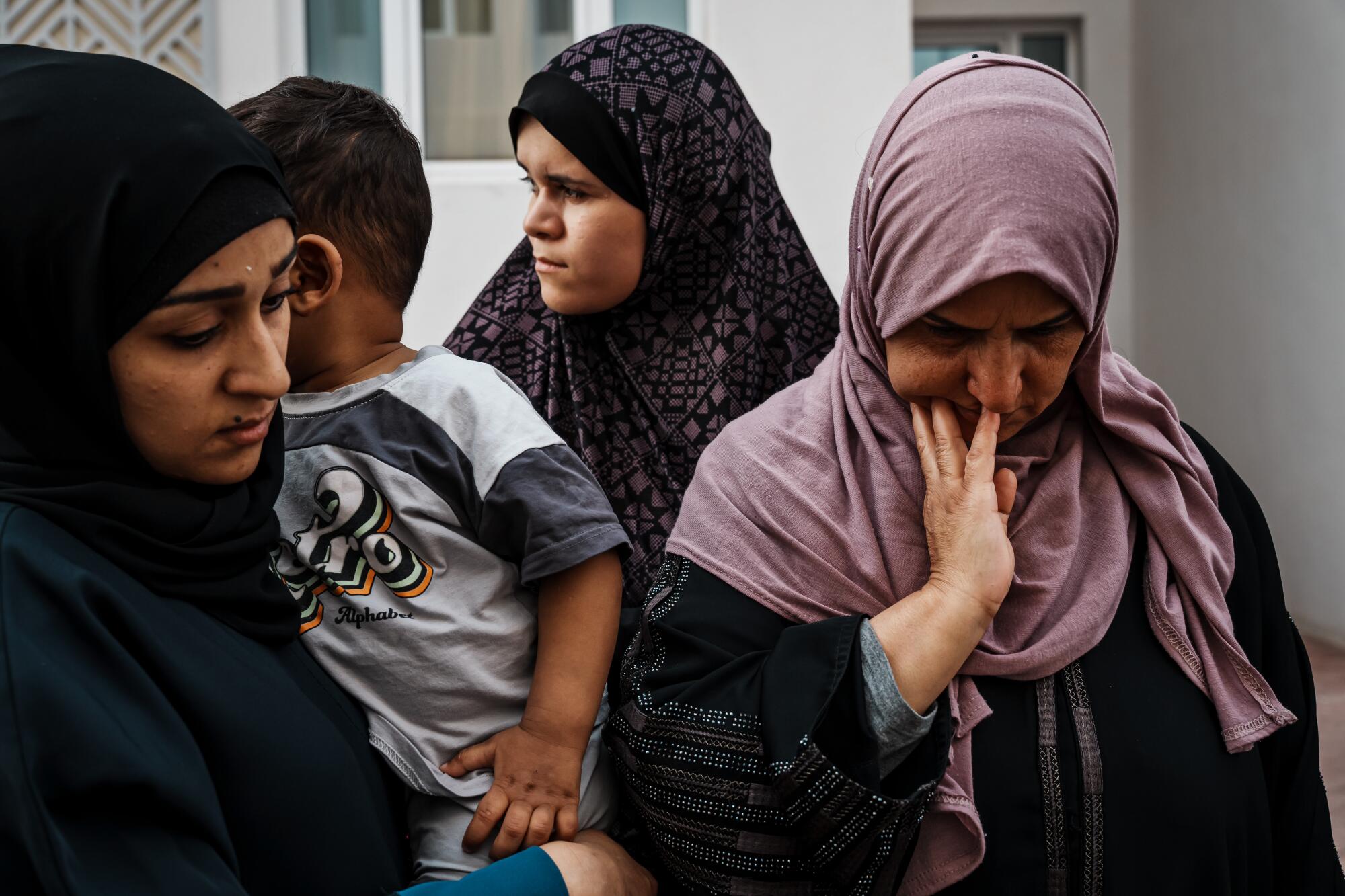

Top, Palestinian women from Gaza speak about the living conditions they left behind amid the Israel-Hamas war. Bottom, Arwa Ghanem, 10, greets one of the student volunteers who come to help Gazan medical evacuees staying in the housing compound in Doha, Qatar.
The three are among the medical evacuees whose injuries are far too severe for Gaza’s collapsing medical system to treat, and who were brought along with some of their relatives to Doha as part of an initiative by Qatar’s emir, Sheikh Tamim bin Hamad Al Thani. After an agreement among Israel, Hamas, Egypt and Qatar, the injured were allowed to leave the Palestinian territory through the southern Gaza city of Rafah and then transported on more than 20 Qatari military flights.
They’re also part of a much larger group of people wounded in Israel’s military offensive in the Gaza Strip since Oct. 7, when Hamas operatives killed roughly 1,200 people in southern Israel and took hostages. In Gaza, in addition to the more than 34,000 killed in Israel’s subsequent attacks, more than 77,000 Palestinians have been wounded, according to the Health Ministry there. In a population where nearly half are younger than 18, the majority of victims have been women and children, the ministry says.
Those who have made it to the Doha compound suffer from life-altering injuries, medical professionals say.
1
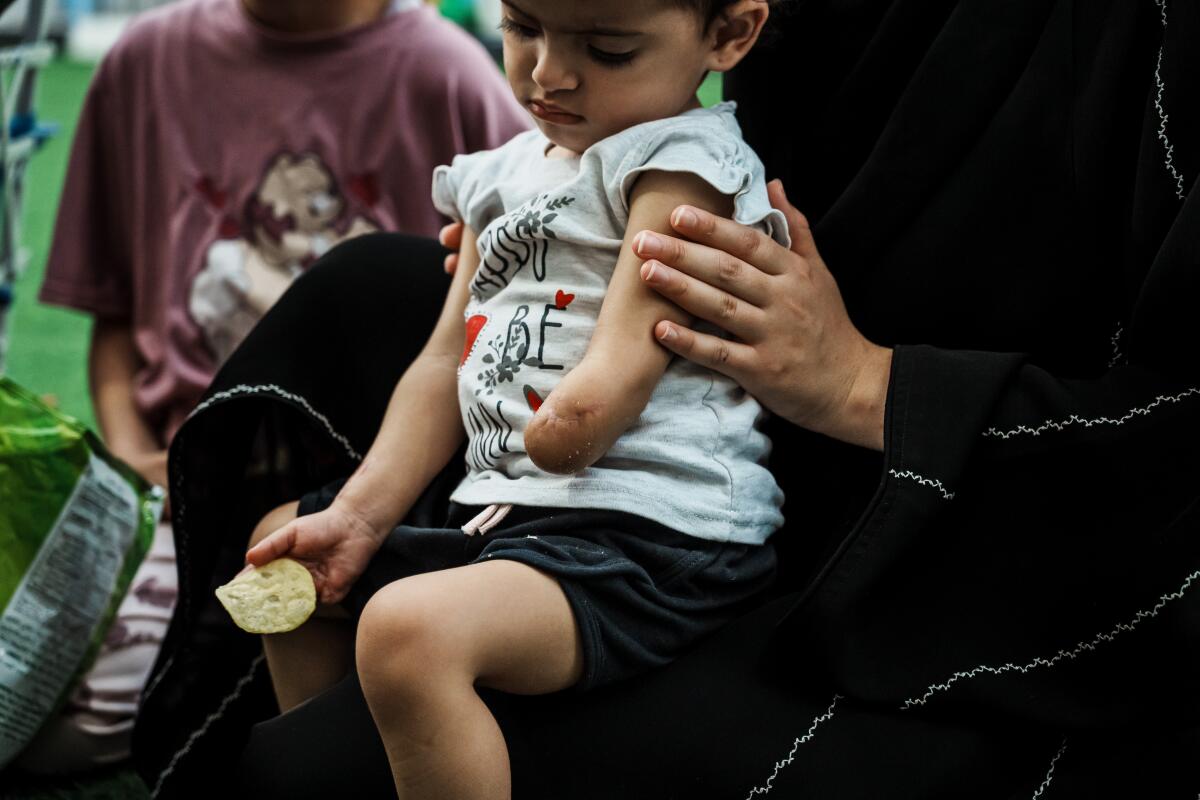
2
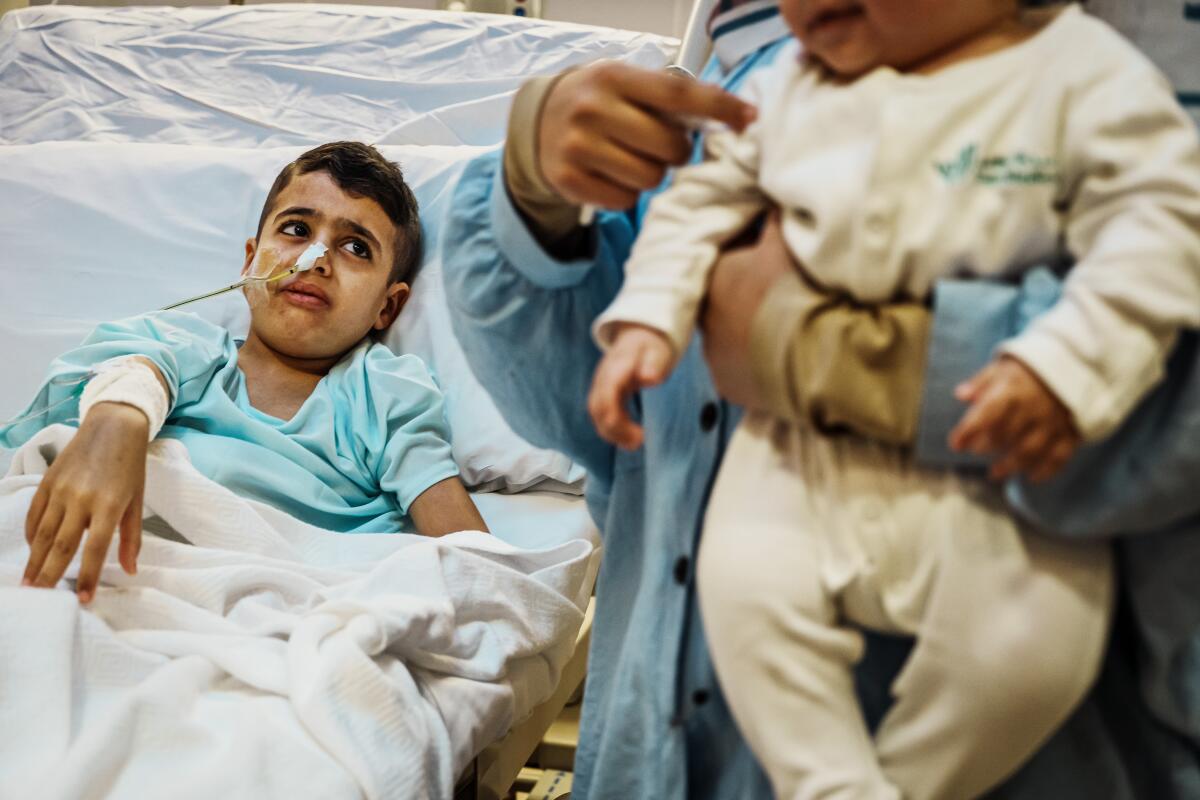
3
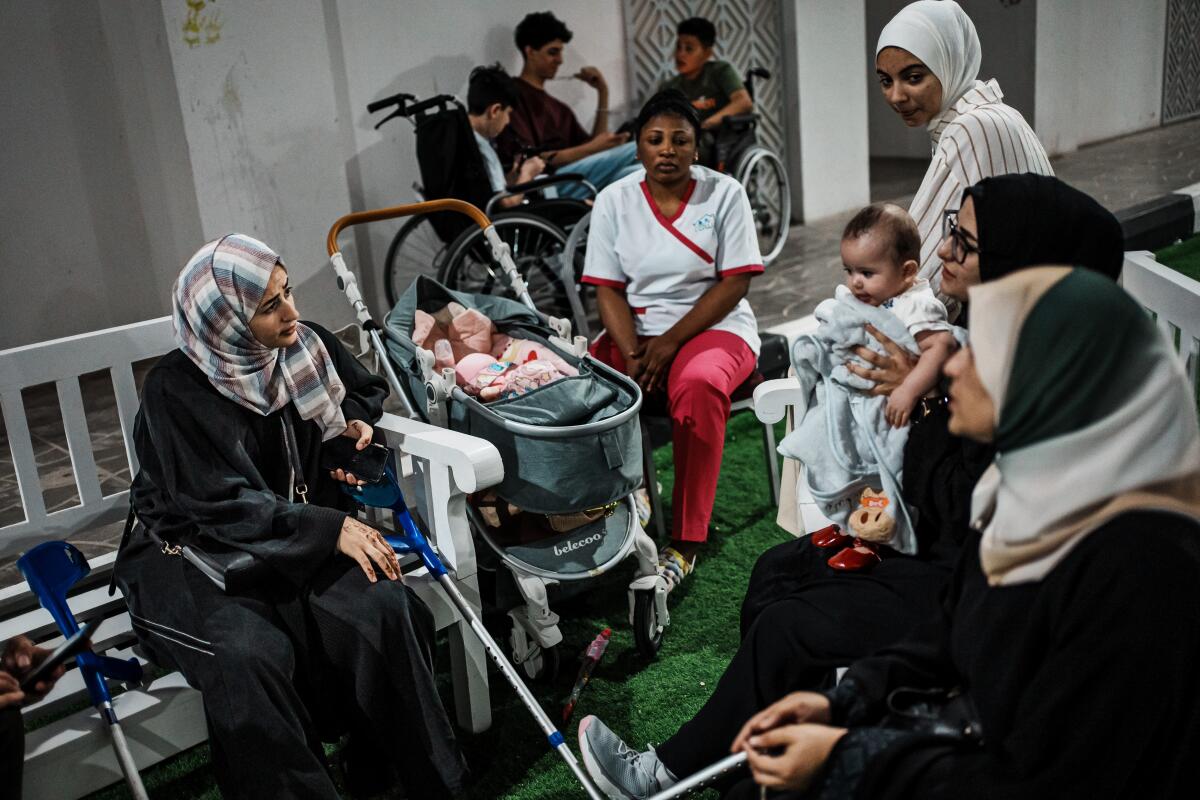
1. Fatima Abu Nasseer 24, holds her 1-year-old niece, Hoor. 2. Yamen Madi, 10, looks on as his mother, Noor Madi, holds his brother inside the pediatric unit for Gazan patients at Sidra Medicine, a hospital in Doha. 3. Palestinian women sit and talk in their temporary home in Doha.
“Burns. Amputations. Head injuries. Fractures. Shrapnel. Crush injuries — we’ve never seen this severity, or this number of amputees, or such severe injuries to internal organs,” said Ahmed al Hammadi, the acting chief medical officer for Sidra Medicine, a 400-bed hospital in Doha that is providing some of the most complex treatments for the evacuated Gazans.
To convalesce, they stay in this compound, and exercise by walking around its well-ordered clusters of three-story buildings and a synthetic turf avenue with a playground and soccer field. When the ferocious Doha sun allows, the children come out to play or visit a recreation center. Some zoom in wheelchairs up and down the streets.
“We were told to expect that the kids are mostly amputees and have major trauma,” said Noura Al Jaber, a 21-year-old volunteer with the Qatar Foundation, which is offering psychological counseling among other services. “But it’s different when you come here. The reality of it hits you.”
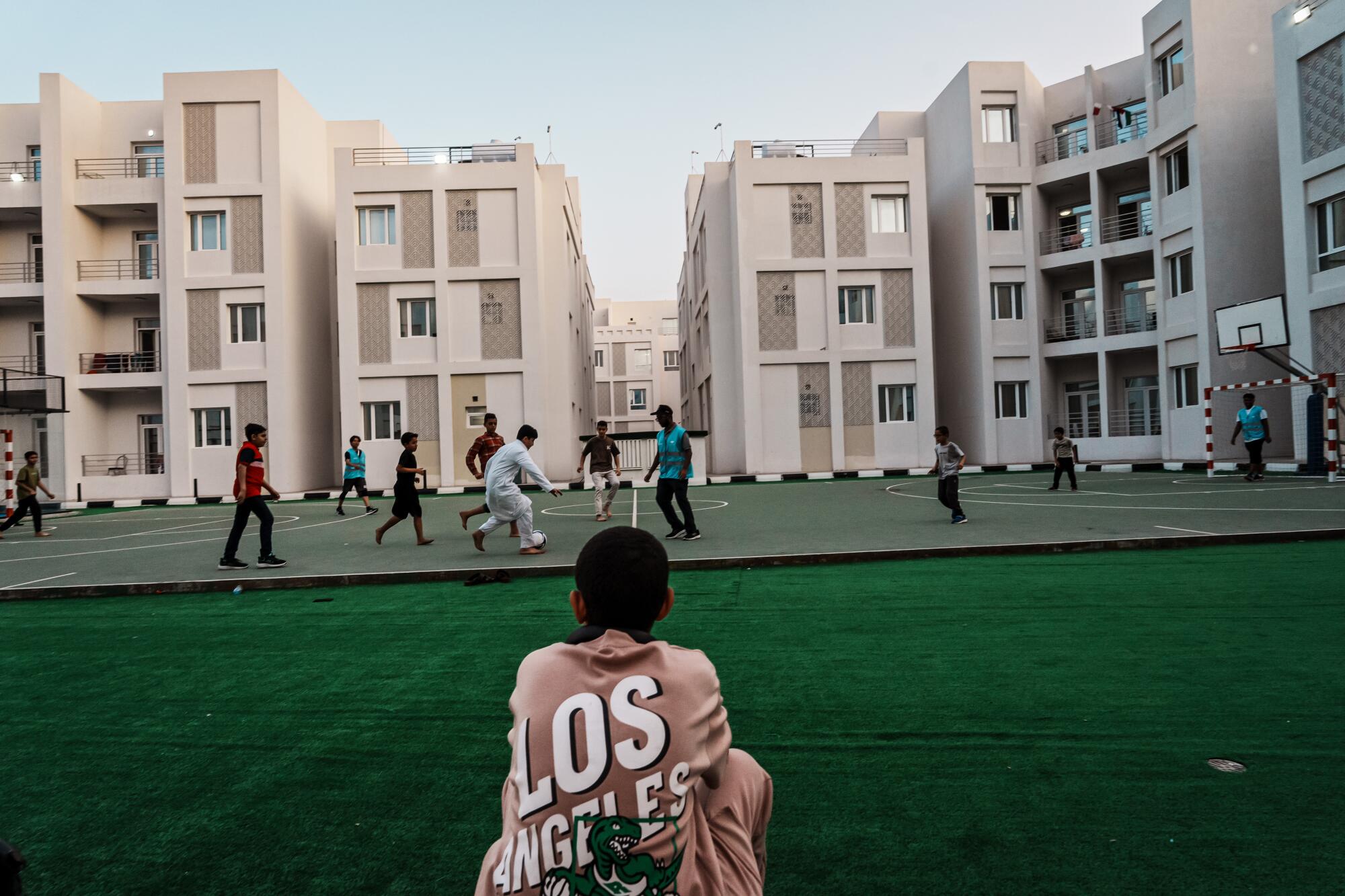
A boy watches volunteers playing soccer with Palestinians from the Gaza Strip.
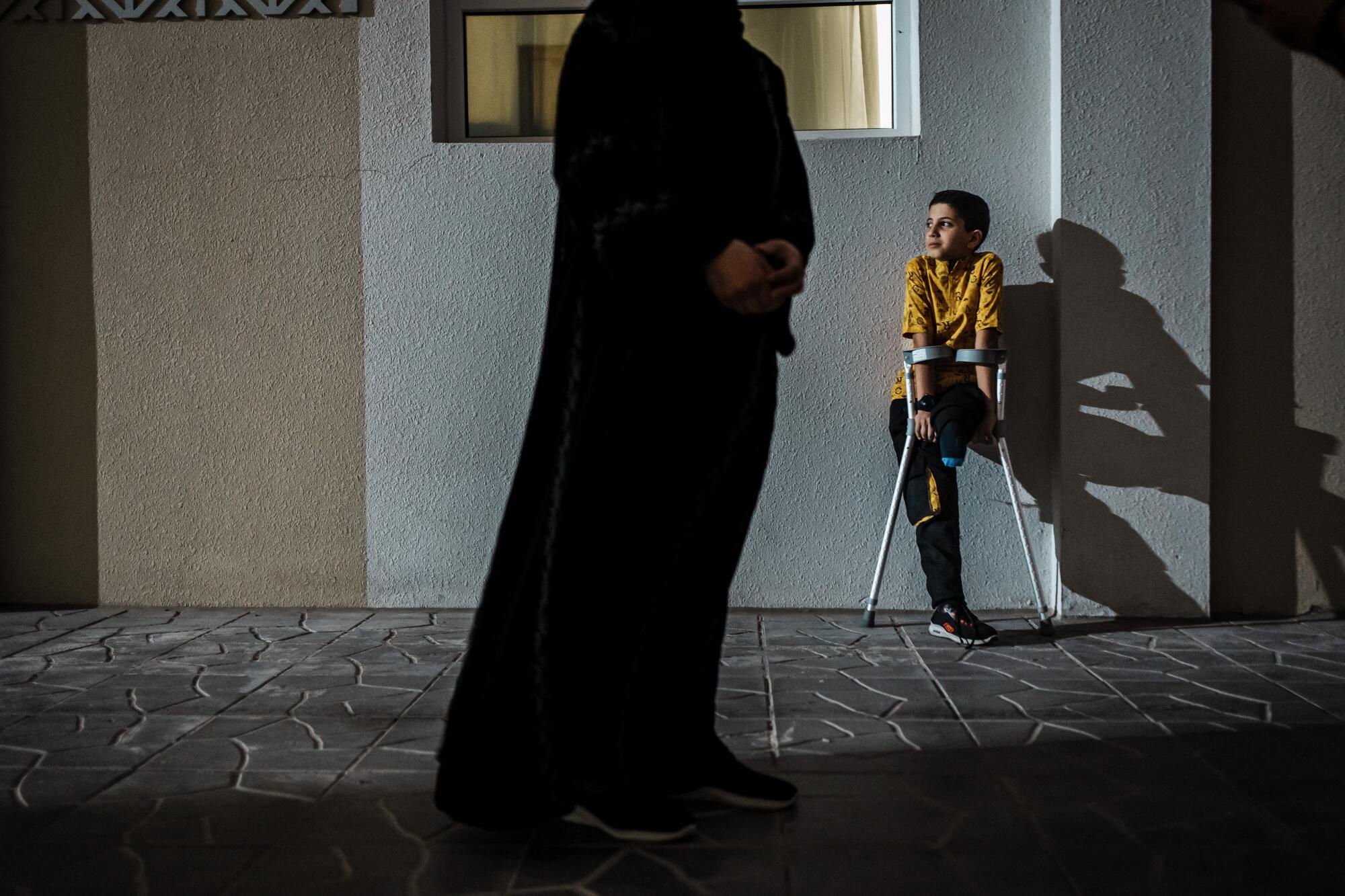
A Palestinian boy is among the 1,500 medical evacuees from Gaza staying in a housing complex in Doha, Qatar.
She was helping set up recreational activities for the children and soon went to the volunteers setting up soccer matches to make sure they could accommodate anyone with disabilities.
“I’ve seen more kids in crutches and mobility aids in the compound than kids walking around.”
::
It was after midnight on Nov. 23 and the call to prayer had just ended when three missiles hit the apartment building in central Gaza where Battah’s family had sought refuge. One didn’t explode, but the others sent a cascade of rubble onto Battah, who was sleeping on the floor beside one of her brothers, Basel, 9, and sister Nada, 13. Nada died instantly. The bones in one of Basel’s legs crumbled under the pressure. Battah’s left foot was hanging by a thread of skin.
“You could see her foot wasn’t attached,” said Battah’s mother, Raedah Nabhan, 43. “If you pulled at it, it would come off in your hand.”
But the doctors in Gaza refused to amputate, hoping to save the foot. They put Battah on medication for three days, then transferred her to another hospital. Three more days passed. By then, infection had set in. Not only could the foot not be saved, but once she got to Doha, her leg would have to be amputated above the knee.
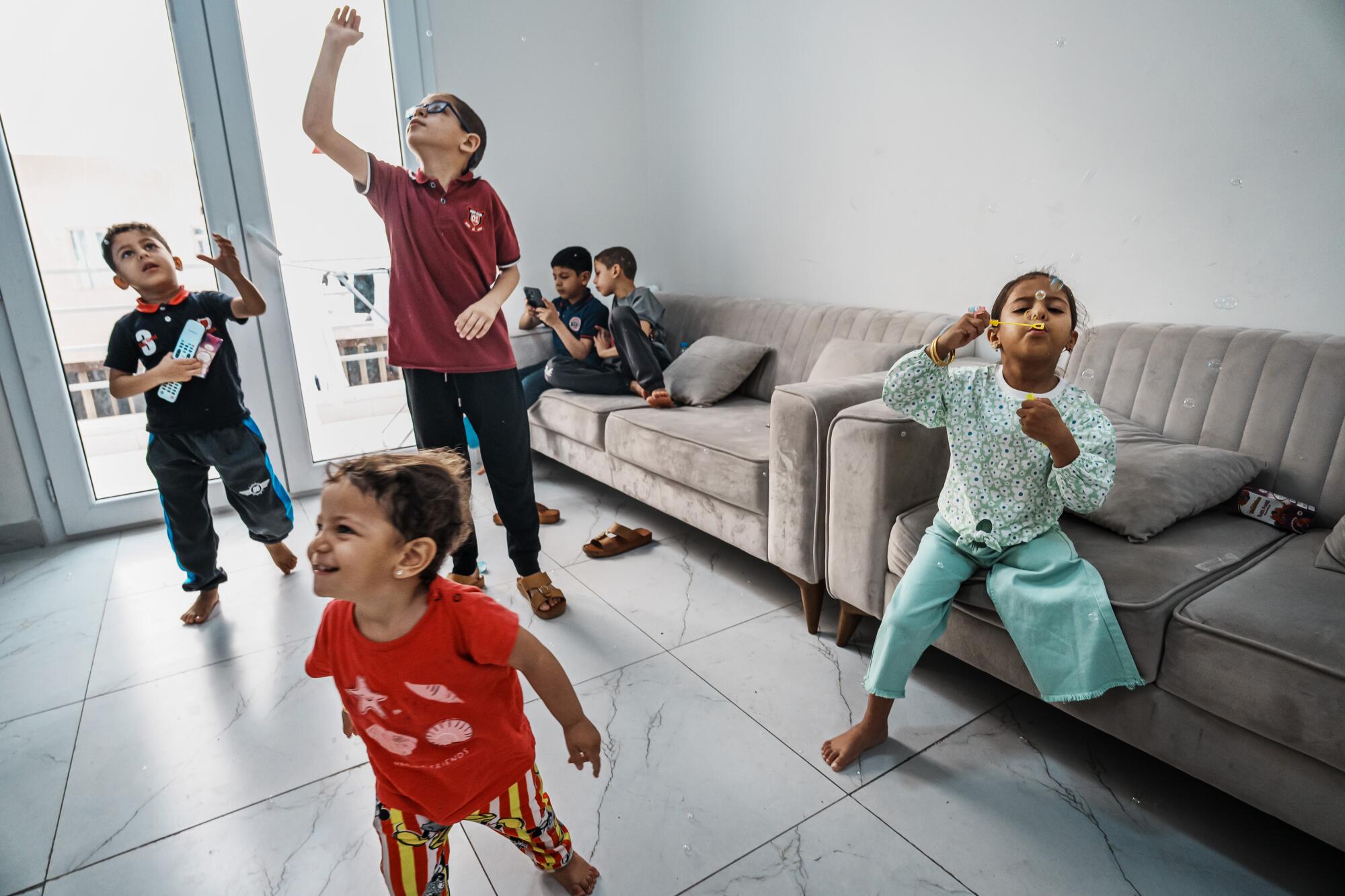
Fatma “Battah” Nabhan, right, plays with her siblings at their temporary apartment in Qatar.
“The first thing she asked me when I saw her in the hospital after the operation was, ‘Will I grow a new leg?’” Nabhan said.
“I told her, ‘We’ll get you the most beautiful leg,’” Nabhan said. “I couldn’t stop crying.”
Like about 40% of the Gaza patients who came to Qatar, Battah could have had a significantly less complicated prognosis had she received proper attention early on, Al Hammadi said.
“They came late,” he said of many patients. “Any delay, there’s a lot of impact. You have to intervene as soon as possible.”
“If you treated it in less than 24 hours, maybe one or two surgeries would be enough. Now we’re talking seven, eight, maybe more.”

Faisal al Khalidi, 5, lies on a bed in the pediatric unit for Gazan patients at Sidra Medicine, a hospital in Doha, Qatar.
And the complexity of many cases has often required more than one surgery at the same time, with three to four specialist surgeons going into the operating room together for hours-long procedures.
One of the patients who faces a particularly difficult road to recovery is 10-year-old Yahya abu Odeh. His family had moved within Gaza several times to try to outrun the violence before settling in at a school-turned-shelter in the Mawasi area. On Feb. 5, Yahya was at the door of a 4th-floor classroom when a piece of shrapnel, barely half a millimeter, lanced through his skull and lodged itself two inches inside.
His mother, Rasha abu Odeh, 36, thought he was dead when she first saw him. She ran and hugged him and heard a heartbeat. But there was no transportation, so she had to carry him two miles until she found someone with a cart. It took five hours before they got to Al Aqsa Martyrs Hospital and saw a doctor.
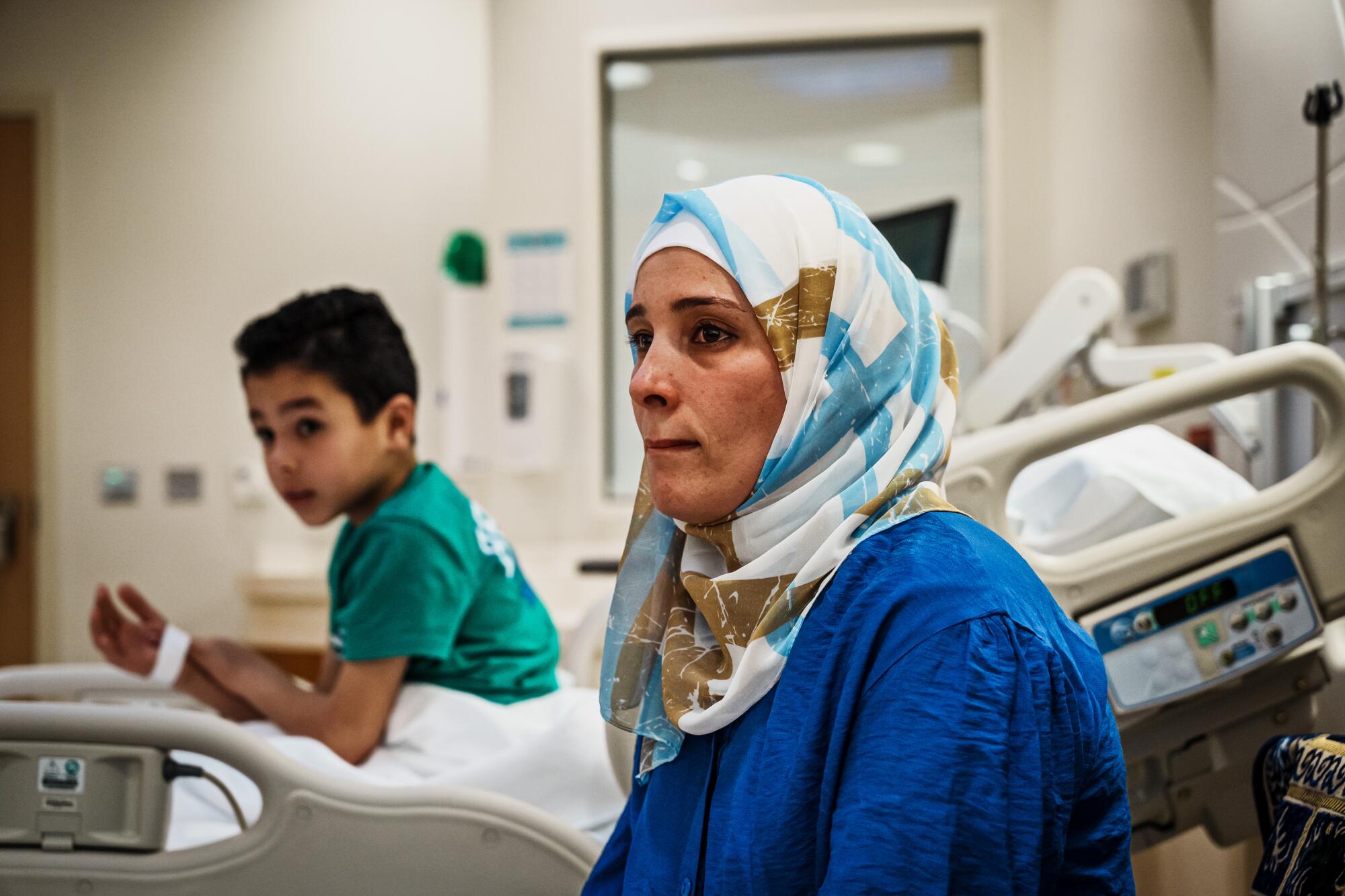
Rasha abu Odeh sits with her 10-year-old son, Yahya, who is awaiting surgery at Sidra Medicine in Doha, Qatar. A piece of shrapnel, barely half a millimeter, is lodged two inches inside his skull.
The hospital was already inundated with casualties. Yahya, who was still unconscious, was admitted but only got a bed days later, when another patient died. Abu Odeh had to chase after overwhelmed doctors, and try to care for her son based on her pharmaceutical training.
Yahya woke up from his coma four days after the attack, but he could not see and had lost function in several limbs. The once rambunctious boy who loved playing with friends was also suffering from short-term memory problems.
With much of the medical infrastructure destroyed, there was little doctors in Gaza could do, so Yahya was put on the list for evacuation. On March 6, Yahya and his mother arrived in Egypt and reached Doha on April 8. Abu Odeh had left behind five other children in Gaza and her husband, who lost his eye in the Israeli attack.
A scan showed the shrapnel had cracked Yahya’s skull and left bone splinters lodged inside, some near the optic nerve. The doctors will operate in a few weeks, after they conduct some tests to determine the shrapnel’s exact location.
In the meantime, Abu Odeh was working on Yahya’s memory, having him recite what he could remember of numbers and the alphabet. So far he remembers nine of the 28 letter in the Arabic alphabet.
“I just pray he’ll see again,” she said.
::
Though Battah’s condition was stable, she too faced a complicated future. She was getting a prosthetic leg in the coming weeks, but it would need to be changed in the coming years.
“You’ll have to do follow-up, a lot, especially in pediatrics,” Al Hammadi said. “Correction [on issues with traumatized bones and amputations] needs more surgeries, because they’re growing. The bone is growing, the muscle, everything is growing.”
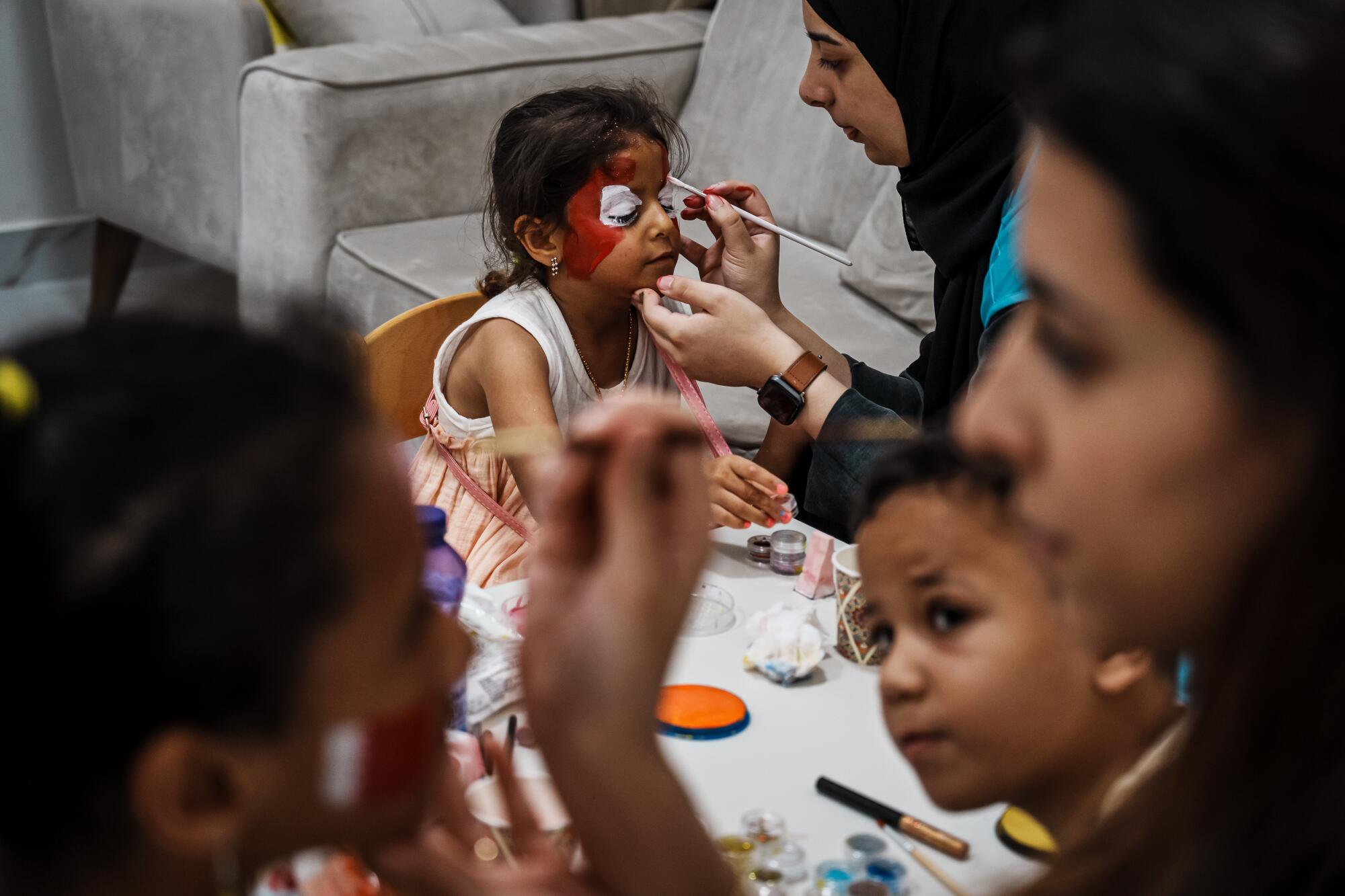
Fatma Nabhan, 5, gets her face painted by volunteer Noura Abu Jaber, 21.
For the moment, playing in the family’s temporary apartment as the noon heat sends residents indoors, Battah appeared unconcerned. She casually maneuvered herself onto the couch to watch cartoons with her toddler sister and four brothers, including Basel, whose leg was still in a cast. Seven-year-old Ibrahim “was the only one who was completely uninjured,” Nabhan said.
Though Battah smiles a lot and appears to have moments of joy, her mother knows there is sadness.
She turned to Battah, and asked her whether she knew what was going to happen to her leg. Battah smiled but said nothing.
“She knows, but she doesn’t talk. Before she would speak to everyone. Now it’s different,” Nabhan said. “And she hates hospitals,” Nabhan said by way of explanation.

Fatma Nabhan holds onto the camera of a visiting photojournalist.
Sometimes, when Battah visits the physical therapist, Nabhan continued, she refuses to speak at all.
“You’d get more words from a stone,” Nabhan says, tearing up at the memory.
Though the children are safe here — “Just sleeping without the sound of drones, that’s enough,” Nabhan said — they hardly feel happy. There were too many family members back home, too much that had been lost. Nabhan had applied for her husband to join her, but it seemed unlikely. And she didn’t know when she could go back to Gaza; she had left without even visiting the cemetery where they buried daughter Nada.
“The kids are OK here. They tell me they don’t want to go back,” Nabhan said.
“When we call their father, we all just sit here and cry.”

Dima abu Amra, 10, from left, Shahed abu Amra, 6, and Dina abu Amra, 10, play in the evening.
As she watched TV, Battah noticed a visiting photojournalist’s camera at her side. She picked it up, declaring it hers now. She started snapping pictures, hopping from one corner of the room to the other and laughing as her mother watched.


